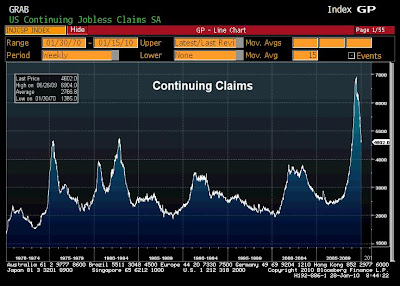So the S&P 500 has slipped 5.7% since touching a15-month high on January 19. This marks only the second 5%-plus dip for this rally – a huge move from the 13-year closing low of 676 that was put in on March 9, recouping 45% of the losses from the all-time high hit on October 9, 2007.
With roughly 40% of S&P 500 members reporting thus far, ex-financial profits are holding onto the 20% increase from the year-ago period. While the percentage of companies beating expectations is surpassing the longer-term average (about 75% of firms have beat expectations, the long-term average is around 60%), we still must get past the bulk of energy, industrial and health-care earnings reports. These groups endured another rough quarter in the final three months of the year, so it will be a challenge to hold onto that 20% growth in ex-financial results – and that rate of growth is going to be what it takes to keep the market at these levels after nine quarters of significant profit deterioration. On the top line, revenues are up 8.8%, but take out financials (a group that has been carried by the Fed as Bernanke has induced a historically positive slope to the yield curve – borrow at near nothing and lend at something much higher, or just buy longer-dated Treasuries), and revenues are slightly negative.
Yesterday’s economic releases also appeared to weigh on investor sentiment. The data was mixed. Durable goods posted a nice number, but the initial jobless claims threw the market for a bit of a loop – as we’ll touch on below.
What’s more, we have these sovereign debt problems continuing to drag on the risk trade – a topic we’ve spent some time on over the previous few weeks and they’re not going away. Greek bonds have really sold off; the yield on their 10-year jumped to 7.18% yesterday from 6.23% at the beginning of the week and 5.98% two weeks back. Last week their finance minister shook off EU bailout speculation by stating the country will handle their financing via the capital markets. Well, while that’s the correct course it is proving to be rather expensive. We’ll watch to see if the EU holds to their statement that they won’t bail the Greeks out. Spain and Portugal, other problems for the Europeans, are also seeing their yields jump. The major debt-financing troubles appear to be confined to these three countries, but it’s another indication of global economic fragility and of course traders wonder that maybe there are more to come.
All of this was good for U.S government bonds and the dollar, which are key safe-havens. The Treasury sold another $32 billion in debt (7-yr notes) and it barely affected rates; this was on the heels of $44B in 2 yrs and $42B in 5 yrs earlier in the week. When it’s all said and done we’ll issue another $2 trillion this year – you may have noticed that the Senate voted yesterday to raise the debt ceiling by $1.9 trillion – they didn’t have much of a choice. This marks the fifth increase in the past two years. Yeehaa boys! Enjoy the low debt servicing while it lasts.
In the final minutes of trading it was reported that the Senate voted 77-23 to end debate and clear the way for a final vote to reappoint Bernanke as Fed Chairman. There was to be no last minute Bernanke bounce though as the market traded slightly lower after the news. After the market closed, the Senate voted 70-30 to officially re-appoint.
Market Activity for January 28, 2010
 Jobless Claims
Jobless ClaimsThe Labor Department reported that initial jobless claims fell just 8,000 to 470,000 in the week ended January 23. The expectation was for a 32,000 decline after initials jumped to 482K in the prior week. The four-week average rose for a second week to 456,250.
 A couple of weeks back it really looked like we were headed for 400K on initial claims, which is a level that almost always suggests at least mild payroll growth. The past two readings have been disappointing.
A couple of weeks back it really looked like we were headed for 400K on initial claims, which is a level that almost always suggests at least mild payroll growth. The past two readings have been disappointing.The continuing claims numbers did offer a glimmer of optimism as both the standard and extended continuing claims data showed a decline. Standard claims, those that provide benefits for 26 weeks, fell 57,000 to 4.602 million. Emergency Unemployment Compensation (EUC) claims also fell, which hasn’t occurred very often since these extensions were implemented in July 2008. EUC claims tumbled 305,000 after the gargantuan increase of 613,000 in the previous week.

 This report definitely shifted from the dynamic we’ve seen over the past couple of months. Initial claims had been falling (illustrating the pace of firings has greatly eased), yet continuing claims were rising (suggesting the absence of hiring as the length of unemployment has been extending). But this report shows the opposite. You want to get excited about the drop in continuing claims, but is it simply a function of benefit exhaustion? Certainly with initials hovering well above the 450K level it sure doesn’t suggest hiring has begun just yet, which leads one to believe the decline in EUC claims is either a transitory pullback from the massive increase in the prior week or the expiration of benefits.
This report definitely shifted from the dynamic we’ve seen over the past couple of months. Initial claims had been falling (illustrating the pace of firings has greatly eased), yet continuing claims were rising (suggesting the absence of hiring as the length of unemployment has been extending). But this report shows the opposite. You want to get excited about the drop in continuing claims, but is it simply a function of benefit exhaustion? Certainly with initials hovering well above the 450K level it sure doesn’t suggest hiring has begun just yet, which leads one to believe the decline in EUC claims is either a transitory pullback from the massive increase in the prior week or the expiration of benefits.Durable Goods Orders
The Commerce Department released a pretty good durable goods report for December. The headline figure rose 0.3%, which followed a downwardly revised 0.4% decline in November. While the December reading was way below the expected 2.0% rise, it was mostly due to a 40% decline in commercial aircraft orders – those orders will probably show a bounce for January after two months of big decline.
The ex-transportation figure, which removes the extremely volatile non-defense aircraft segment, rose 0.9% -- nearly double the expected increase. This marks the second-straight increase for ex-trans durable goods orders.
The segment of the report to concentrate on is the non-defense capital goods ex-aircraft reading, the proxy for business-equipment investment. The figure rose a very nice 1.3% in December after a strong +3.1% in November. The problems on this side occurred within the computer/electronics and electrical equipment components – down 3.0% and 3.9% for the month (although electrical equipment posted two nice increases in the prior months, so nothing to worry about there). The machinery component made up for it though, jumping 6.0%.
Orders for vehicles and parts rose 3.6% for the month and have increased seven of the past eight months. Auto assemblies will play a key role regarding the inventory boost to GDP, but I question whether it is lasting (a theme I keep returning to) as auto sales are very likely to remain choppy.
This is good news but we need this trend to extend for several months. My belief is that firms are going to keep their cash held close and not take any big bets with regard to future activity. That is, they will manage business-equipment purchases to maintenance levels. This will be helpful based on where we’re coming from, as business spending had collapsed with a swiftness and degree never before seen in the postwar era, but such caution will not allow for the normal rebound in capital expenditures – it’s the uncertainty, stupid.
By the time we get into late-spring/early-summer we’ll have a good sense as to whether this view proves accurate or something larger, and hopefully more substantial, is occurring. It all depends on Washington clearing uncertainties regarding future tax rates and coming regulations.
Today’s Data
Today’s focus will be on the fourth-quarter GDP report and Chicago PMI (factory survey).
The consensus estimate for GDP is 4.6%, but most expect a reading closer to 5%. The average for this quarter (Q4 GDP) should be in a range of 6%-9% -- this is the average one-quarter removed from the three-worst prior recessions in the postwar era. But a print around 5% will be good enough, particularly since the previous reading was revised down in such a dramatic manner – originally printing 3.5%, but revised down to 2.2% by time all the revisions were in. The welcome durables goods data of the past two months is going to help us get that fiver; GDP is going to be fueled by some inventory rebuilding.
The Chicago PMI data is always heavily watched, maybe more so today as the two regional factory gauges we’ve received thus far for January have been conflicting – one good and one not so.
Have a great day!
Brent Vondera, Senior Analyst

No comments:
Post a Comment